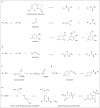Role of chemistry in nature-inspired skin adhesives
- PMID: 40474951
- PMCID: PMC12134755
- DOI: 10.1039/d5sc01777g
Role of chemistry in nature-inspired skin adhesives
Abstract
As an essential component of wearable technology, skin adhesion plays a critical role in a wide range of wearable device applications. To maintain effectiveness and safety in daily use, skin adhesives must exhibit strong wet adhesion and high biocompatibility, particularly for devices that remain in contact with the skin for extended periods under humid and dynamic conditions. A comprehensive understanding of skin adhesion's chemical mechanisms is fundamental to advancing this technology. Nature offers valuable inspiration, as numerous organisms have evolved sophisticated chemical and physical adhesion strategies that enable strong and reversible bonding. This review begins by exploring the historical development of nature-inspired skin adhesives, followed by a detailed examination of their performance in moist environments. Particular emphasis is placed on the covalent and non-covalent interactions between adhesive materials and skin surface functional groups, considering both biocompatibility and wet adhesion properties. Additionally, we discuss strategies to mitigate hydration-related challenges alongside an overview of characterization techniques, including mechanical, chemical, and biological testing methods. The classification of nature-inspired skin adhesives into chemical and physical approaches is presented, highlighting their applications in thermal management, energy harvesting, wound care, and transdermal drug delivery. Finally, we identify current limitations and propose design strategies to guide the development of next-generation skin adhesives, providing a clear trajectory for future research.
This journal is © The Royal Society of Chemistry.
Conflict of interest statement
There are no conflicts to declare.
Figures















Similar articles
-
The use of Open Dialogue in Trauma Informed Care services for mental health consumers and their family networks: A scoping review.J Psychiatr Ment Health Nurs. 2024 Aug;31(4):681-698. doi: 10.1111/jpm.13023. Epub 2024 Jan 17. J Psychiatr Ment Health Nurs. 2024. PMID: 38230967
-
Systemic pharmacological treatments for chronic plaque psoriasis: a network meta-analysis.Cochrane Database Syst Rev. 2017 Dec 22;12(12):CD011535. doi: 10.1002/14651858.CD011535.pub2. Cochrane Database Syst Rev. 2017. Update in: Cochrane Database Syst Rev. 2020 Jan 9;1:CD011535. doi: 10.1002/14651858.CD011535.pub3. PMID: 29271481 Free PMC article. Updated.
-
Systemic pharmacological treatments for chronic plaque psoriasis: a network meta-analysis.Cochrane Database Syst Rev. 2021 Apr 19;4(4):CD011535. doi: 10.1002/14651858.CD011535.pub4. Cochrane Database Syst Rev. 2021. Update in: Cochrane Database Syst Rev. 2022 May 23;5:CD011535. doi: 10.1002/14651858.CD011535.pub5. PMID: 33871055 Free PMC article. Updated.
-
Home treatment for mental health problems: a systematic review.Health Technol Assess. 2001;5(15):1-139. doi: 10.3310/hta5150. Health Technol Assess. 2001. PMID: 11532236
-
Acceptability of 'as needed' biologic therapy in psoriasis: insights from a multistakeholder mixed-methods study.Br J Dermatol. 2024 Jul 16;191(2):243-251. doi: 10.1093/bjd/ljae068. Br J Dermatol. 2024. PMID: 38366988
References
Publication types
LinkOut - more resources
Full Text Sources
Research Materials

